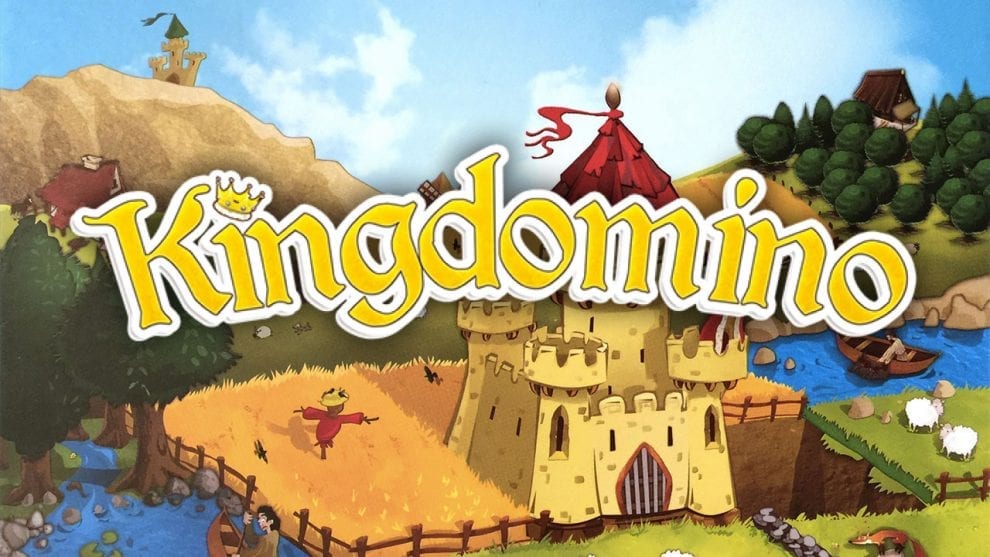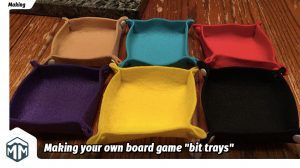Kingdomino Overview
The game of Kingdomino, from veteran designer Bruno Cathala, is a short and simple game of tile laying & matching, but one that reveals hidden tactical depths as players try to outmaneuver one another in a bid to build the most prosperous kingdom.
In Kingdomino players take turns selecting the choicest plots of land to add to their growing kingdom. Planning ahead is the name of the game as players can always see one complete turn ahead. The choice between a high value tile which forces you to pick last next turn, and a lower value tile allowing you to go first is as distinct as the very double sided domino-style tiles from which you’re choosing. Arrange the most crowns and conjoined plots of land in a 5×5 grid to lead your kingdom to victory.
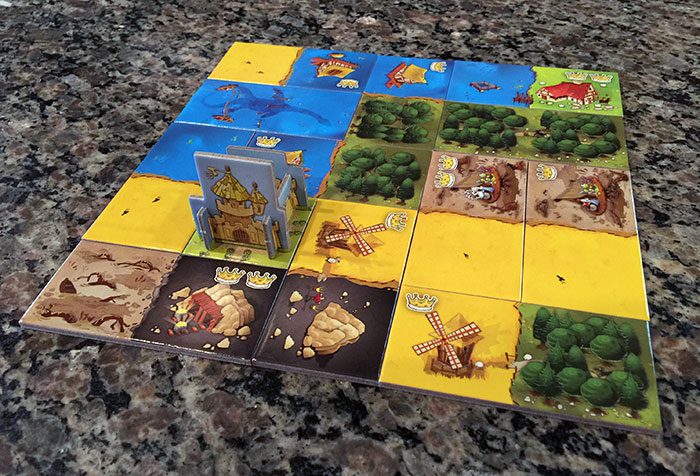
How to Set Up Kingdomino
Setting up a game of Kingdomino is simple and straightforward. Remove all 48 sequentially numbered tiles from the box and place them number side up. Mix them thoroughly and remove the proper number for your player count, placing them back in the box. In a 2 player basic game remove 24, in a 3p game remove 12, and in a 4p game you’ll be using all of them. Give each player a matching set of castle and pawn, along with a single starting land tile and the game is afoot.
The designer and publisher offer an official 2 player variant which has players using all 48 tiles, building a massive 7×7 kingdom.
How to Play Kingdomino
Draw a number of tiles from the stack equal to the player count, and arrange them in numeric order with the lowest number nearest the box and the highest number furthest from the box.
Turn the tiles face up to expose the landscape side. Collect all player pawns and shake them in a bag, or your hand, and reveal them one at a time, with the revealed player placing their pawn on one of the landscape tiles. Each tile may have only a single pawn placed on it.
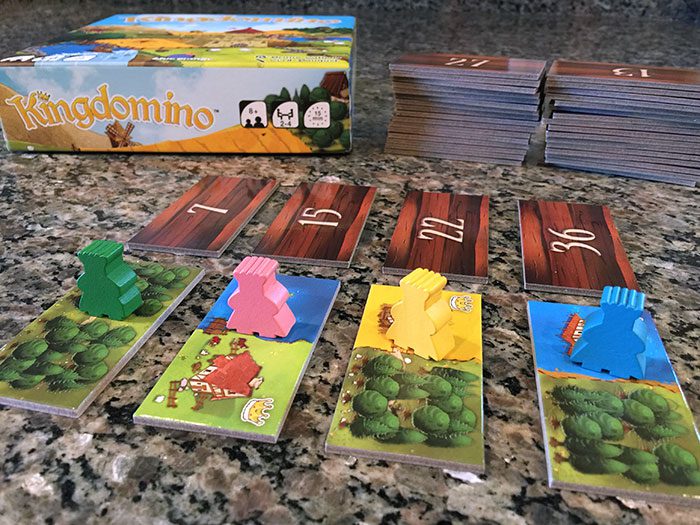
Lay out another row of tiles, and place them face up with the lowest numbered tile near the box. Starting with the tile closest to the box each player will then remove their player pawn, taking the tile their piece occupied and placing it into their kingdom (more on placement in a moment). After removing their pawn they immediately place it onto one of the new tiles.
This process repeats until all of the tiles have been claimed and placed into kingdoms, and then final scoring occurs. The player with the most points wins.
Placing Tiles
In general, the higher the tile’s number the more valuable it is. Lower numbered tiles are great for taking up lots of space, while higher number tiles have valuable crowns.

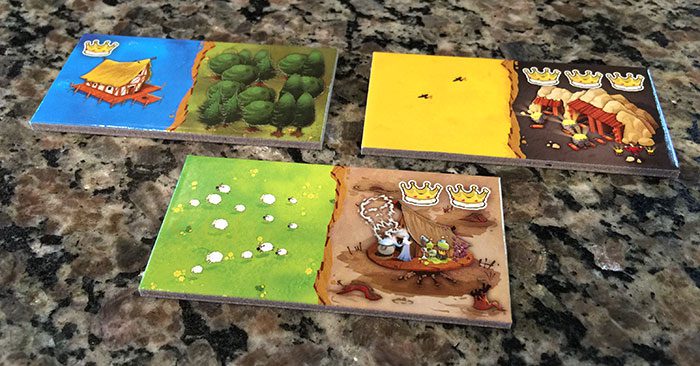
48 double-sided tiles offer a lot of variety, but how do you actually place these beautifully illustrated landscapes into your kingdom? By following these 3 simple rules:
- In the basic game, the player’s kingdom must not exceed a 5×5 grid.
- A tile must be connected either to the player’s castle (which acts as a wild) or to another landscape tile which matches at least one of the terrains on the tile being placed.
- If a tile cannot be placed it must be discarded and no points will be awarded for it. (This means it is possible for a player to have open spaces in their kingdom.)

Scoring in Kingdomino
After all tiles have been drawn and placed (or discarded) players will score their kingdoms. Scoring is comprised of two parts:
- The number of crowns in a contiguous region
- The total number of tiles in that same region
For each distinct region in a player’s kingdom, they will multiply the two numbers above, then total their points. The player with the most prestige points will win the game!
“Wait wait wait!” you might say. “Yes that sounds simple, but how about an example?”
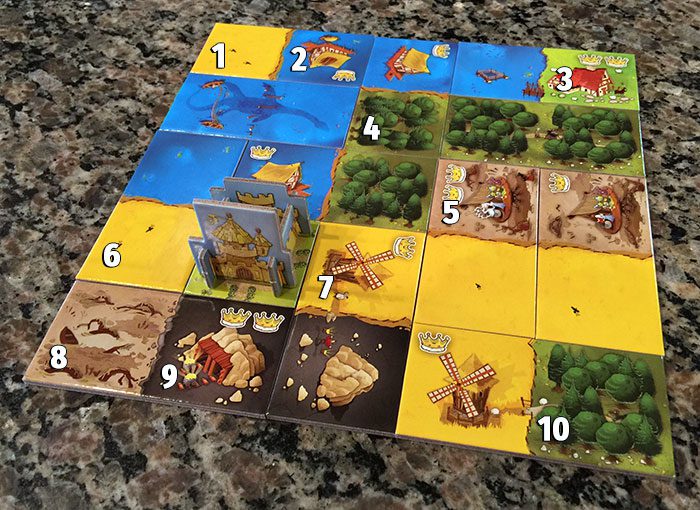
In the example above, the yellow player has 10 distinct regions and would score the following points for each:
| 1 | 1 squares | 0 crowns | 0 points |
| 2 | 7 squares | 3 crowns | 21 points |
| 3 | 1 squares | 2 crowns | 2 points |
| 4 | 4 squares | 0 crowns | 0 points |
| 5 | 2 squares | 3 crowns | 6 points |
| 6 | 1 squares | 0 crowns | 0 points |
| 7 | 4 squares | 2 crowns | 8 points |
| 8 | 1 squares | 0 crowns | 0 points |
| 9 | 2 squares | 2 crowns | 4 points |
| 10 | 1 squares | 0 crowns | 0 points |
| For a total of 41 points! | |||
What I Like About Kingdomino
Kingdomino is beautifully illustrated by artist Cyril Bouquet, with rich blues, vibrant yellows, and deep greens. Each individual square is unique and interesting (can you find the sea monster?). The player pawns have a nice shape to them, and are also pleasantly large. While Kingdomino is primarily two-dimensional, the addition of the player castles give the game visual interest and a bit of extra whimsy.

Kingdomino is a delightful take on dominos with some very clever additions. The mix of 6 different landscapes, the clever turn order / tile selection approach, and the multiplicative style scoring all combine to make a game that is both fun and engaging.
On any given turn several tiles might suit your needs, but players will need to decide if they’d rather go for that tile with the crown, or sacrifice an extra bit of scoring to be able to pick that perfect tile next round. Players will also have to determine if they want to risk gaps in their kingdom to place a tile in exactly the right spot.
Final Thoughts on Kingdomino
Kingdomino is a small game, only 8 inches square, and 2 inches tall. But within this Lilliputian box lies a game of Brobdingnagian proportions. At first glance Kingdomino is a contradiction, the straight lines and hard angles of the tiles, the soft pastel pawns, and brightly colored land tiles, but they all come together in a pleasing package: a quick to teach, easy to play game which can be enjoyed by everyone.
Kingdomino really fits my sweet spot for clever and interesting games that play under 30 minutes, and in fact Kingdomino usually plays in less than 15 minutes. Bruno Cathala really hit this one out of the park and Kingdomino is a game that everyone should try. Perfect for all ages, easy to carry around with you, durable components, great gameplay, and a low price point; what’s not to love about Kingdomino? Go get it today!


